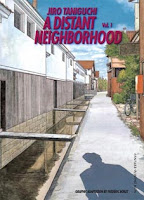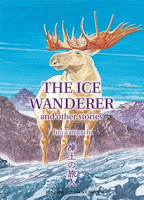My News and Reviews
Last week the Blue Exorcist Giveaway Winner was announced. The post also includes a pretty great list of some favorite manga that was read in 2012 by those who entered the giveaway. I also managed to post two reviews last week. The first was for Yaya Sakuragi’s boys’ love manga Bond of Dreams, Bond of Love, Volume 2. Bond of Dreams, Bond of Love isn’t my favorite Sakuragi manga, but I’m still amused and entertained by it. I also reviewed Isuna Hasekura’s Spice & Wolf, Volume 7: Side Colors, a collection of three side stories to the main series. It’s not essential reading, but still a nice addition to the series for fans of Spice & Wolf.
In other news, I finished reading Persona: A Biography of Yukio Mishima by Naoki Inose and Hiroaki Sato. (The book is enormous, so I consider it to be an accomplishment.) I’m planning on posting an in-depth review of Persona next week, but I wanted to mention a section included in the biography called “A Paean to Manga” which briefly explores Mishima’s thoughts and opinions on manga. Mishima actually really like manga. He wasn’t a fan of Shirato Sanpei, but he loved Hirata Hiroshi (which I previously knew) and Akatsuka Fujio and liked Mizuki Shigeru’s yokai stories. He is quoted as saying, “Compared with American comics, Japanese graphic tales are a shade more grim and dark both in eroticism and cruelty. To make up for it, though, they are avant-garde in nonsense.”I thought this was interesting and wanted to share.
Elsewhere, some very exciting developments in comics publishing were revealed last week! Kuriousity interviewed Jen Lee Quick, creator of Off*Beat (among other things) which I really enjoy. The first two volumes of Off*Beat were published by Tokyopop, but the series was left unfinished. Happily, Quick was able to get the rights to her work back. The series will be reprinted, and completed, by the newly established Chromatic Press. For more information about Chromatic Press, check out Brigid Alverson’s exclusive at MTV Geek—Chromatic Press Launches New Manga Magazine, Brings Back Off*Beat. I’m very excited about Chromatic Press and what its trying to do.
A couple more more manga publishing developments that I wanted to mention. At Good E-Reader, Brigid Alverson looks at Gen Manga’s plans for the year—GEN Manga Offers Free E-Books, Prepares to Launch Korean Comics Magazine. And on Twitter, Vertical mentioned in passing that its Keiko Takemiya licenses will be expiring this summer. This means that Andromeda Stories and To Terra… will be going out of print. I’m a huge fan of Takemiya’s work. To Terra… in particular is a fantastic space opera and is definitely worth picking up before it disappears.
Quick Takes
 Eyeshield 21, Volumes 1-7 written by Riichiro Inagaki and illustrated by Yusuke Murata. Despite watching every single football game in high school and college (I was in the marching band), I’ve never really been a fan of American football. I picked up Eyeshield 21 mainly because it is illustrated by Murata who many of the artists I follow admire. Sena, a rather timid high school first year, has developed impressive running skills, mostly as a way to flee from bullies. But this also makes him an ideal candidate for the running back of the Deimon Devil Bats, his school’s football club. Eyeshield 21 turned out to be a surprisingly fun, entertaining, and slightly ridiculous series. And yes, Murata’s artwork is great.
Eyeshield 21, Volumes 1-7 written by Riichiro Inagaki and illustrated by Yusuke Murata. Despite watching every single football game in high school and college (I was in the marching band), I’ve never really been a fan of American football. I picked up Eyeshield 21 mainly because it is illustrated by Murata who many of the artists I follow admire. Sena, a rather timid high school first year, has developed impressive running skills, mostly as a way to flee from bullies. But this also makes him an ideal candidate for the running back of the Deimon Devil Bats, his school’s football club. Eyeshield 21 turned out to be a surprisingly fun, entertaining, and slightly ridiculous series. And yes, Murata’s artwork is great.
 Genshiken, Omnibus 2 (equivalent to Volumes 4-6) by Shimoku Kio. I’m continuing to enjoy this otaku slice-of-life series. After nearly burning down one of the university’s buildings at the end of the last omnibus, this volume finds the Genshiken club homeless and assigned to community service as penance. New characters and proclivities are introduced which creates some conflict within the group. I love that most of the Genshiken members are completely comfortable with themselves as otaku. They might occasionally be embarrassed, but they aren’t ashamed. There is one notable exception: Ogiue claims to hate all otaku although she is one herself, but she seems to be coming around. I also am greatly amused by how often porn comes up as part the group’s discussions.
Genshiken, Omnibus 2 (equivalent to Volumes 4-6) by Shimoku Kio. I’m continuing to enjoy this otaku slice-of-life series. After nearly burning down one of the university’s buildings at the end of the last omnibus, this volume finds the Genshiken club homeless and assigned to community service as penance. New characters and proclivities are introduced which creates some conflict within the group. I love that most of the Genshiken members are completely comfortable with themselves as otaku. They might occasionally be embarrassed, but they aren’t ashamed. There is one notable exception: Ogiue claims to hate all otaku although she is one herself, but she seems to be coming around. I also am greatly amused by how often porn comes up as part the group’s discussions.
 Samurai Legend written by Kan Furuyama and illustrated by by Jiro Taniguchi. Yagyū Jūbei is a famous swordsman who was active during the Tokugawa era in Japan. Although there are few confirmed facts about his life, he has become a popular legendary figure. Samurai Legend is more than two decades old now, but it’s still a great historical one-shot. It was actually the first historical manga on which Taniguchi worked as an artist. His efforts paid off—the manga is filled with dynamic action sequences and believable battles. The characters don’t need superpowers to have amazing and impressive martial skill. Taniguchi also deliberately strives to be as historically accurate as possible in Samurai Legend.
Samurai Legend written by Kan Furuyama and illustrated by by Jiro Taniguchi. Yagyū Jūbei is a famous swordsman who was active during the Tokugawa era in Japan. Although there are few confirmed facts about his life, he has become a popular legendary figure. Samurai Legend is more than two decades old now, but it’s still a great historical one-shot. It was actually the first historical manga on which Taniguchi worked as an artist. His efforts paid off—the manga is filled with dynamic action sequences and believable battles. The characters don’t need superpowers to have amazing and impressive martial skill. Taniguchi also deliberately strives to be as historically accurate as possible in Samurai Legend.
 Sweet Revolution written by Serubo Suzuki and illustrated by Yukine Honami. Tatsuki and Ohta are two transfer students who aren’t nearly as human as they first appear and the young men’s relationship is more complicated than their classmates realize. The first two chapters of Sweet Revolution are told from the perspective of Kouhei, one of their classmates, and have a slightly different tone than the rest of the volume. But then the manga begins to explore the pair’s history and motivations more directly. The storytelling builds quite nicely from there. I particularly enjoyed the supernatural elements in Sweet Revolution. I didn’t realize when I began reading the manga that in part it would be a yokai tale. And, well, I happen to like yokai.
Sweet Revolution written by Serubo Suzuki and illustrated by Yukine Honami. Tatsuki and Ohta are two transfer students who aren’t nearly as human as they first appear and the young men’s relationship is more complicated than their classmates realize. The first two chapters of Sweet Revolution are told from the perspective of Kouhei, one of their classmates, and have a slightly different tone than the rest of the volume. But then the manga begins to explore the pair’s history and motivations more directly. The storytelling builds quite nicely from there. I particularly enjoyed the supernatural elements in Sweet Revolution. I didn’t realize when I began reading the manga that in part it would be a yokai tale. And, well, I happen to like yokai.
 Fist of the North Star: The TV Series, Volume 1 (Episodes 1-36) directed by Toyoo Ashida. While at this point I can safely say that I prefer the Fist of the North Star manga, I’m still getting a kick out of the anime adaptation. Granted, a large part of this first box set is a bit of a grind and rather repetitive. The beginning of the manga started out in a similar way, so I wasn’t entirely surprised. However, the anime has a lot of filler at the beginning. But even so, I enjoyed myself. I can’t help but like Kenshiro, one of the most stoic badasses that I know of. Plus, there’s plenty of over-the-top martial arts in the series. I’m really looking forward to watching more of Fist of the North Star.
Fist of the North Star: The TV Series, Volume 1 (Episodes 1-36) directed by Toyoo Ashida. While at this point I can safely say that I prefer the Fist of the North Star manga, I’m still getting a kick out of the anime adaptation. Granted, a large part of this first box set is a bit of a grind and rather repetitive. The beginning of the manga started out in a similar way, so I wasn’t entirely surprised. However, the anime has a lot of filler at the beginning. But even so, I enjoyed myself. I can’t help but like Kenshiro, one of the most stoic badasses that I know of. Plus, there’s plenty of over-the-top martial arts in the series. I’m really looking forward to watching more of Fist of the North Star.















